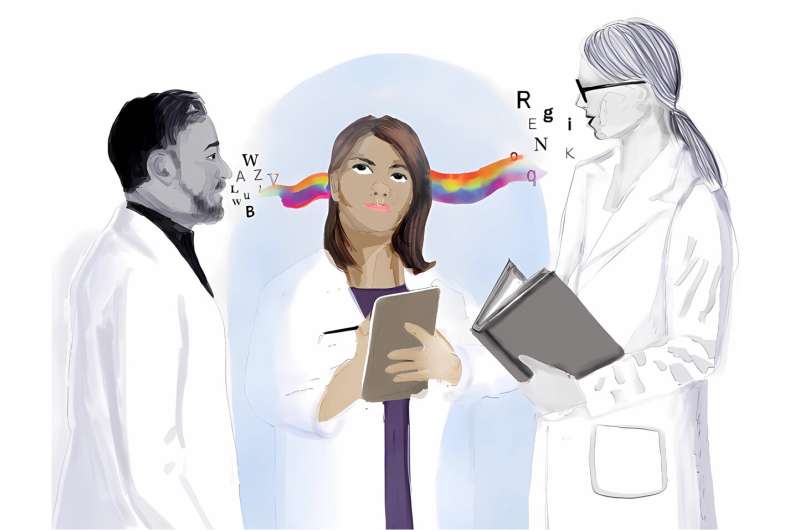This article has been reviewed according to Science X's editorial process and policies. Editors have highlighted the following attributes while ensuring the content's credibility:
fact-checked
peer-reviewed publication
trusted source
proofread
Reviewing systemic problems for autistic adults in STEMM: Q&A

AJ Hinton, assistant professor of molecular physiology and biophysics, Amber Crabtree, graduate student in the Department of Molecular Physiology and Biophysics, and colleagues have collaborated on a commentary about the challenges facing autistic adults in science, technology, engineering, math, and medicine.
As autistic adults face a high unemployment rate, the authors argue that solutions are necessary to evoke change within STEMM institutions so that they are more inclusive for autistic students and employees.
"The ongoing under-utilization of autistic talent in the STEMM workforce is a major missed opportunity for the nation's STEMM enterprise, not to mention for quality of life and meaningful engagement of autistic scientists," said Keivan Stassun, director of Vanderbilt's Frist Center for Autism and Innovation.
"While there is a rapidly growing awareness about this issue, the scholarly literature has a long way to go in terms of offering evidence-based findings and solutions, as well as centering authentic autistic voices. This article is a significant contribution because it does both."
The review "Recruiting and retaining autistic talent in STEMM" was published in iScience on March 15, 2024.
Crabtree answered some of our questions related to this review.
What problem does your research address?
Autism, a neurological and developmental difference that can cause difficulties in communication and social interactions, is estimated to be present in more than 5 million adults in the United States, according to the Center for Disease Control and Prevention. This group of adults faces high unemployment rates—around 40% of autistic adults are employed, but just around 15% have full-time jobs.
Systemic changes are needed to acquire and retain autistic adults in STEMM. In our commentary, we present the unique challenges autistic adults face in STEMM and possible solutions to overcome them.
What was unique about your approach to the research?
Most prior research uses a deficit-based approach, which alters the experimental design and can lead to unintentional bias. Instead, we focus on the unique ways in which autistic adults can enrich STEMM career fields and bring their strengths and abilities to the workforce.
Our team works with diverse individuals across Vanderbilt University, so we decided to look at the literature from a strengths-based approach that does not view autism as a negative, but rather an asset which, with the proper skillset, can be valuable.
What were your findings?
The challenges faced by autistic adults in society, especially in STEMM fields are significant. However, there are ways to mitigate this and help autistic adults feel more included and supported.
Making conscious efforts to communicate effectively and creating environments that accommodate unique needs can reduce feelings of exclusion. For example, it is seen more and more that journals and social media have become a tool for neurodivergent individuals. These platforms can be a way to showcase the diversity of both needs and strengths of different neurodivergent experiences.
It's important to recognize that autistic individuals have diverse experiences and strengths, and we should focus on fostering those strengths rather than solely viewing autism from a deficit-based perspective.
Some simple changes in how we interact and communicate can make a big difference for some autistic individuals, while others may require more support due to social, emotional, and cognitive difficulties. Therefore, it's crucial to educate people at all levels about how to effectively support and work with autistic individuals to ensure their full inclusion in society and the workforce.
What do you hope will be achieved with the research results in the short term?
In the short-term, we hope people will be able to expand their view about the roles of autistic adults in STEMM. Both autistic individuals and institutions need to work together to improve employment opportunities and dismantle barriers that exclude autistic individuals from participating fully in society.
This requires a multi-faceted approach involving changes at the social, systemic, and professional levels, as well as education and training for both employers and employees, which we hope can be begin with this call to action.
What are the long-term societal/environmental/economic benefits of this research?
Despite the increasing prevalence of autism, participation of autistic individuals in STEMM fields may be decreasing. We hope to reverse these worrying long-term trends and shift away from viewing autism from a deficit-based perspective.
Where is this research taking you next? What will you personally be doing, or how will other researchers build on this work?
Within the DEI, there needs to be more data-backed research. In the future, we hope our team and others will continue to study the positive aspects of autistic inclusion within the STEMM.
More information: Amber Crabtree et al, Recruiting and retaining autistic talent in STEMM, iScience (2024). DOI: 10.1016/j.isci.2024.109080





















